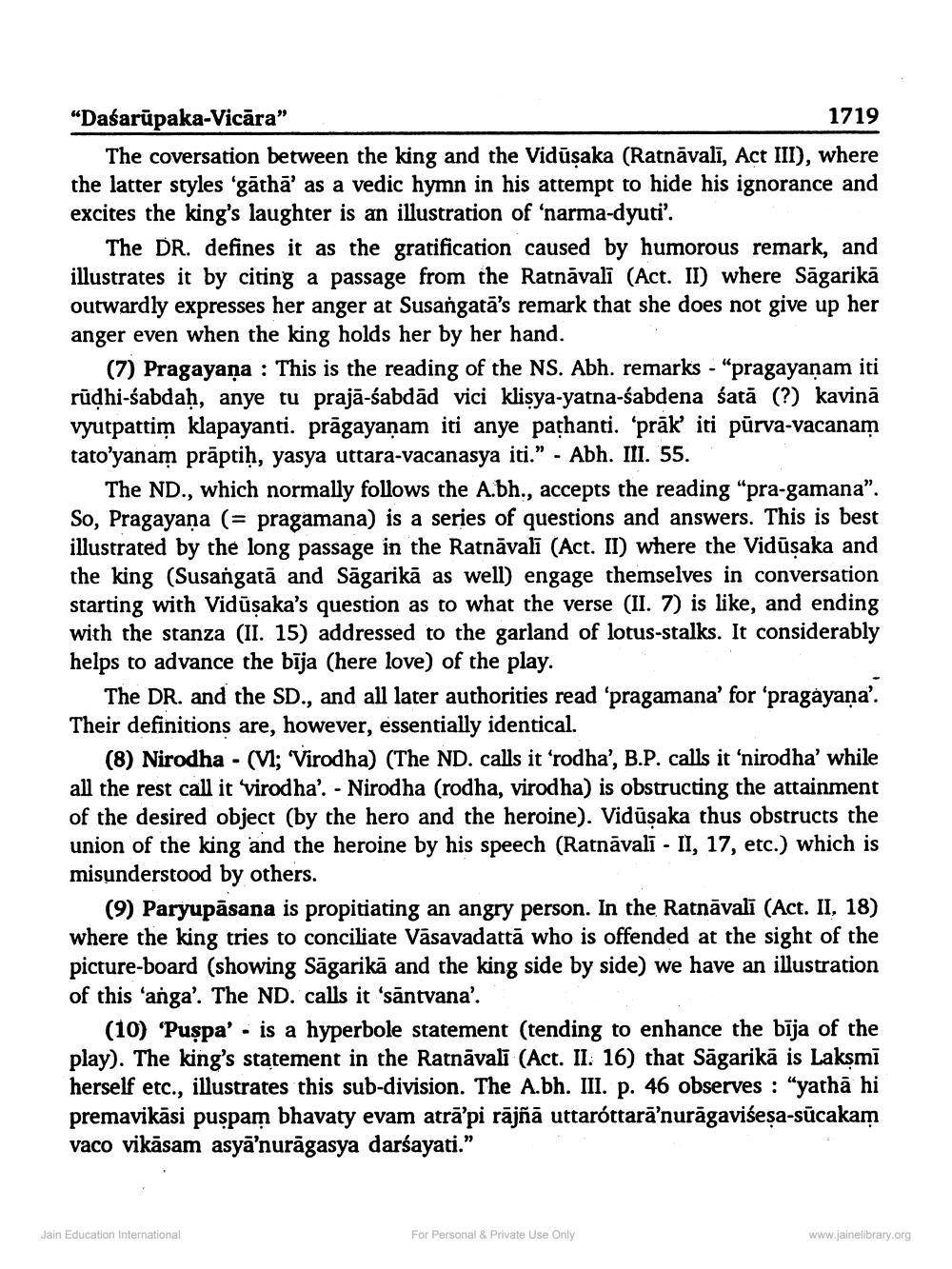________________
"Dasarūpaka-Vicāra"
1719 The coversation between the king and the Vidūsaka (Ratnāvalī, Act III), where the latter styles 'gāthā' as a vedic hymn in his attempt to hide his ignorance and excites the king's laughter is an illustration of 'narma-dyuti'.
The DR. defines it as the gratification caused by humorous remark, and illustrates it by citing a passage from the Ratnāvali (Act. II) where Sagarikā outwardly expresses her anger at Susangatä's remark that she does not give up her anger even when the king holds her by her hand.
agayana : This is the reading of the NS. Abh. remarks - "pragayanam iti rūdhi-sabdah, anye tu prajā-sabdād vici klisya-yatna-sabdena satā (?) kavinā vyutpattim klapayanti. prāgayanam iti anye parhanti. 'prāk’ iti pūrva-vacanam tato’yanam prāptiḥ, yasya uttara-vacanasya iti.” - Abh. III. 55.
The ND., which normally follows the Aibh., accepts the reading “pra-gamana”. So, Pragayana (= pragamana) is a series of questions and answers. This is best illustrated by the long passage in the Ratnāvalī (Act. II) where the Vidūsaka and the king (Susangatā and Sāgarikā as well) engage themselves in conversation starting with Vidūsaka's question as to what the verse (II. 7) is like, and ending with the stanza (II. 15) addressed to the garland of lotus-stalks. It considerably helps to advance the bija (here love) of the play.
The DR. and the SD., and all later authorities read 'pragamana' for 'pragayana'. Their definitions are, however, essentially identical.
(8) Nirodha - (V1; Virodha) (The ND. calls it ‘rodha', B.P. calls it ‘nirodha' while all the rest call it virodha'. - Nirodha (rodha, virodha) is obstructing the attainment of the desired object (by the hero and the heroine). Vidūsaka thus obstructs the union of the king and the heroine by his speech (Ratnāvali - II, 17, etc.) which is misunderstood by others.
(9) Paryupāsana is propitiating an angry person. In the Ratnāvali (Act. II, 18) where the king tries to conciliate Vāsavadattā who is offended at the sight of the picture-board (showing Sāgarika and the king side by side) we have an illustration of this 'anga'. The ND. calls it 'sāntvana'.
(10) 'Puşpa' - is a hyperbole statement (tending to enhance the bīja of the play). The king's statement in the Ratnāvalī (Act. II. 16) that Sāgarikā is Lakşmi herself etc., illustrates this sub-division. The A.bh. III. p. 46 observes : "yathā hi premavikāsi puspam bhavaty evam atrā'pi rājñā uttaróttarā'nurāgaviśesa-sūcakam vaco vikāsam asya'nurāgasya darśayati."
Jain Education International
For Personal & Private Use Only
www.jainelibrary.org




